I view dance as THE liberal art.
When working within the concert dance realm, we combine movement with music, acting, and principles of visual art while exploring topics in other academic disciplines. This helps provide meaning behind each motion and informs the process by which we create.
When I hear some K-12 (and studio) dance educators talk about the works they and their students present, I often feel they are missing what I consider to be my favorite part of teaching- getting kids to think about real things in real ways. This should include the field of dance.

But what if your career has never ventured into professional dance performance? What if your college dance experience only explored a small number of methods in making dances? What if your understanding of process means little more than practicing dances over and over until they are “performance ready”? What does “performance ready” even mean?
.
Concert Dance, to me, is determined by process- the ways movement is inspired, how it is developed, edited, and finally presented. The style of dance is irrelevant in many respects, it is all about the intent and the journey, which lead to the product.
If this idea is new to you, here is a ten-step list of how to engage in a process. The order of these events could certainly be played with, as could the methods for determining these events.
The point, however, remains singular: Choosing opportunities that raise understanding, value, and aesthetics of art-making.
1. Choose content.
Find content with enough depth that it can be explored from multiple angles, voices, and perspectives.
What is the dance about? This may be the inter-disciplinary concept (linking dance with math, science, language, social studies,….), studying the nuances of dance styles, creating a visual representation of the musical score, or some other notion for a “theme”.
2. Choose genre.
Which style of dance best suits the idea or concept you are presenting?
3. Choose movement.
How do you go about creating movement? Do you rely on a repertoire of steps or do you create movement that best supports your idea, even if it doesn’t have a “name”? Should you start by asking students to improvise to key words relating to the concept?
4. Choose structure.
Dances don’t have to be choreographed from beginning to end. Try creating large movement phrases that can be ordered in different ways, layered in contrasting movement, or fragmented.
Based on the concept, does it make sense for the piece to begin with a single figure and move to a large group or reverse?
How might the concept inform the relationship of performers to one another? To the audience? To the space?
5. Choose sound.
Does the piece need music or could it be danced to text, silence, or unconventional sound?
If you select music, play with the relationship to lyrics. I tend to avoid lyrics within my own choreography, but I sometimes use lyrics to add irony or additional depth to my choreography.

6. Choose alternate methods for coaching ideas and movement.
Guide the dancers to a shared vision regarding what each motion means rather than (just) the precision of unison movement.
Talk through the meaning behind each movement, ask students to write about their experiences, and/or provide tools such as pictures, articles, videos relating to the concept and process.
7. Choose rehearsal methods.
Repetition is not the only way to clean a work, nor does it foster a relationship with the work that can keep it from “peaking” before it goes on-stage.
Plan your warm-up to warm-up bodies and minds. Think beyond plies and tendus to encourage dancers to be in the moment of the dance rather than (just) executing steps clearly. Perhaps the inclusion of dance improvisation could be of help in this way.
8. Choose production elements.
What kind of showing is best? How important are costumes? Lights?
9. Choose your value system.
What determines good v. bad? How do you measure the success of the process as well as the success of the work?
Encourage students (and parents) to see the value of ideas and the creation of the work over the precision of the dancers.
10. Choose a method for reflection.
Again, ask students to write about their experiences in order to gather their ideas and separate themselves from the personal attachment to the piece. When it comes to class discussion, they will have an easier time finding their voices and will be able to speak with clearer heads.
What other processes could be explored next time? Did the time-frame support the experience?
Next month, I will explain how dance history can be explored to further enrich the concert-making experience and provide students with a greater sense of “place” within the legacy of dance.
Until then, here are some additional articles relating to concert dance:
- What is Artistry and How Do I Develop It?
- Why and How to Encourage Students to See Concert Dance
- Watching and Discussing Dance
- The Costume “Blackout” Keeps Choreography Center Stage
How do you lead students through the creative process?
Do these 10 steps reflect your own choreographic process?
Heather Vaughan-Southard MFA, is a choreographer, dance educator, and performer based in Michigan. She currently directs the dance program at the Everett High School Visual and Performing Arts Magnet in Lansing. With the philosophy of teaching dance as a liberal art, Ms. Vaughan-Southard collaborates with numerous arts and education organizations throughout the state. She has danced professionally in Chicago, Detroit, Los Angeles, and New York and has performed works by Mia Michaels, Lar Lubovitch, Donald McKayle, Billy Siegenfeld, Alexandra Beller, Debra Levasseur-Lottman, and Bob Fosse. As a choreographer, her work has been credited by the Los Angeles Times for “creating heat.” She has recently choreographed for the dance programs at Michigan State University, Grand Valley State University, Lansing Community College and is the former dance professor at Albion College. She is a regular guest artist and blogger for Dance in the Annex, an innovative dance community in Grand Rapids. Heather received her MFA in Dance from the University of Michigan, BFA in Dance from Western Michigan University and K-12 certification in Dance from Wayne State University. Read Heather’s posts.

